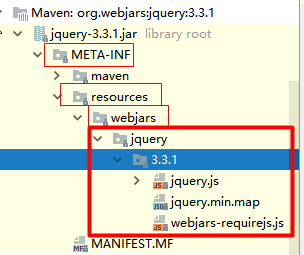SpringBoot源码学习之路(五、Web开发之静态资源映射分析)
Web开发
一、简介
使用SpringBoot:
1)、创建SpringBoot应用,选中我们需要的模块;
2)、SpringBoot已经默认将这些场景配置好了,只需要在配置文件中指定少量配置就可以运行起来
3)、自己编写业务代码;
这个场景SpringBoot帮我们配置了什么?能不能修改?能修改哪些配置?能不能扩展?
xxxxAutoConfiguration: 帮我们给容器中自动配置组件;
xxxxProperties: 配置类来封装配置文件的内容;二、SpringBoot对静态资源的映射规则;
1.源码分析
首先要看看SpringBoot web依赖模块的源码:
ResourceProperties.class:
@ConfigurationProperties(
prefix = "spring.resources",
ignoreUnknownFields = false
)
//可以设置和静态资源有关的参数,缓存时间等
public class ResourceProperties {
private static final String[] CLASSPATH_RESOURCE_LOCATIONS = new String[]{"classpath:/META-INF/resources/", "classpath:/resources/", "classpath:/static/", "classpath:/public/"};
private String[] staticLocations;
private boolean addMappings;
private final ResourceProperties.Chain chain;
private final ResourceProperties.Cache cache;再看看自动配置依赖包下web模块的 WebMvcAutoConfiguration .class中的部分源码:
public class WebMvcAutoConfiguration {
//为静态资源映射规则
public void addResourceHandlers(ResourceHandlerRegistry registry) {
if (!this.resourceProperties.isAddMappings()) {
logger.debug("Default resource handling disabled");
} else {
Duration cachePeriod = this.resourceProperties.getCache().getPeriod();
CacheControl cacheControl = this.resourceProperties.getCache().getCachecontrol().toHttpCacheControl();
//此处为静态资源映射规则一:webjars的引入依赖的映射
if (!registry.hasMappingForPattern("/webjars/**")) {
this.customizeResourceHandlerRegistration(registry.addResourceHandler(new String[]{"/webjars/**"}).addResourceLocations(new String[]{"classpath:/META-INF/resources/webjars/"}).setCachePeriod(this.getSeconds(cachePeriod)).setCacheControl(cacheControl));
}
String staticPathPattern = this.mvcProperties.getStaticPathPattern();
//此处为静态资源映射规则二:本地静态资源文件夹映射
if (!registry.hasMappingForPattern(staticPathPattern)) {
this.customizeResourceHandlerRegistration(registry.addResourceHandler(new String[]{staticPathPattern}).addResourceLocations(getResourceLocations(this.resourceProperties.getStaticLocations())).setCachePeriod(this.getSeconds(cachePeriod)).setCacheControl(cacheControl));
}
}
}
//配置欢迎页映射
@Bean
public WelcomePageHandlerMapping welcomePageHandlerMapping(
ResourceProperties resourceProperties) {
return new WelcomePageHandlerMapping(resourceProperties.getWelcomePage(),
this.mvcProperties.getStaticPathPattern());
}
//网站的图标配置
@Configuration
@ConditionalOnProperty(value = "spring.mvc.favicon.enabled", matchIfMissing = true)
public static class FaviconConfiguration {
private final ResourceProperties resourceProperties;
public FaviconConfiguration(ResourceProperties resourceProperties) {
this.resourceProperties = resourceProperties;
}
@Bean
public SimpleUrlHandlerMapping faviconHandlerMapping() {
SimpleUrlHandlerMapping mapping = new SimpleUrlHandlerMapping();
mapping.setOrder(Ordered.HIGHEST_PRECEDENCE + 1);
//所有 **/favicon.ico
mapping.setUrlMap(Collections.singletonMap("**/favicon.ico",
faviconRequestHandler()));
return mapping;
}
@Bean
public ResourceHttpRequestHandler faviconRequestHandler() {
ResourceHttpRequestHandler requestHandler = new ResourceHttpRequestHandler();
requestHandler
.setLocations(this.resourceProperties.getFaviconLocations());
return requestHandler;
}
}
}2.映射规则总结
(1)、所有 /webjars/**请求,都去 classpath:/META-INF/resources/webjars/ 找资源。
(webjars:以jar包的方式引入静态资源(如jquery等静态资源)。资源网站:http://www.webjars.org/)
如springboot引入jquery:
<dependency>
<groupId>org.webjarsgroupId>
<artifactId>jqueryartifactId>
<version>3.3.1version>
dependency>当访问【localhost:8080/webjars/jquery/3.3.1/jquery.js 】 ,就相当于去依赖包下的【classpath:/META-INF/resources/webjars/】找相应的【jquery.js】文件
(2)、所有”/**”的请求,如果没有对应的处理,都去(静态资源的文件夹,如下)找相映射的资源:
"classpath:/META-INF/resources/",
"classpath:/resources/",
"classpath:/static/",
"classpath:/public/"
"/":当前项目的根路径如:【 localhost:8080/abc】(当/abc请求没有对应的处理,那么SpringBoot会去去静态资源文件夹里面找abc)
(3)、欢迎页; 静态资源文件夹下的所有index.html页面;被”/**”映射;==
即访问localhost:8080/ Springboot会处理 自动去静态文件夹 找index页面
(4)、所有的 **/favicon.ico 都是在静态资源文件下找;==
如: 直接找个favicon.ico放在静态资源文件夹下即可
(5)、当自己使用 spring.resources.static-locations 配置指定静态文件夹,那么前面那些默认的静态资源文件夹就会失效。
如: spring.resources.static-locations = classpath:/hello/,classpath:/hello2/
